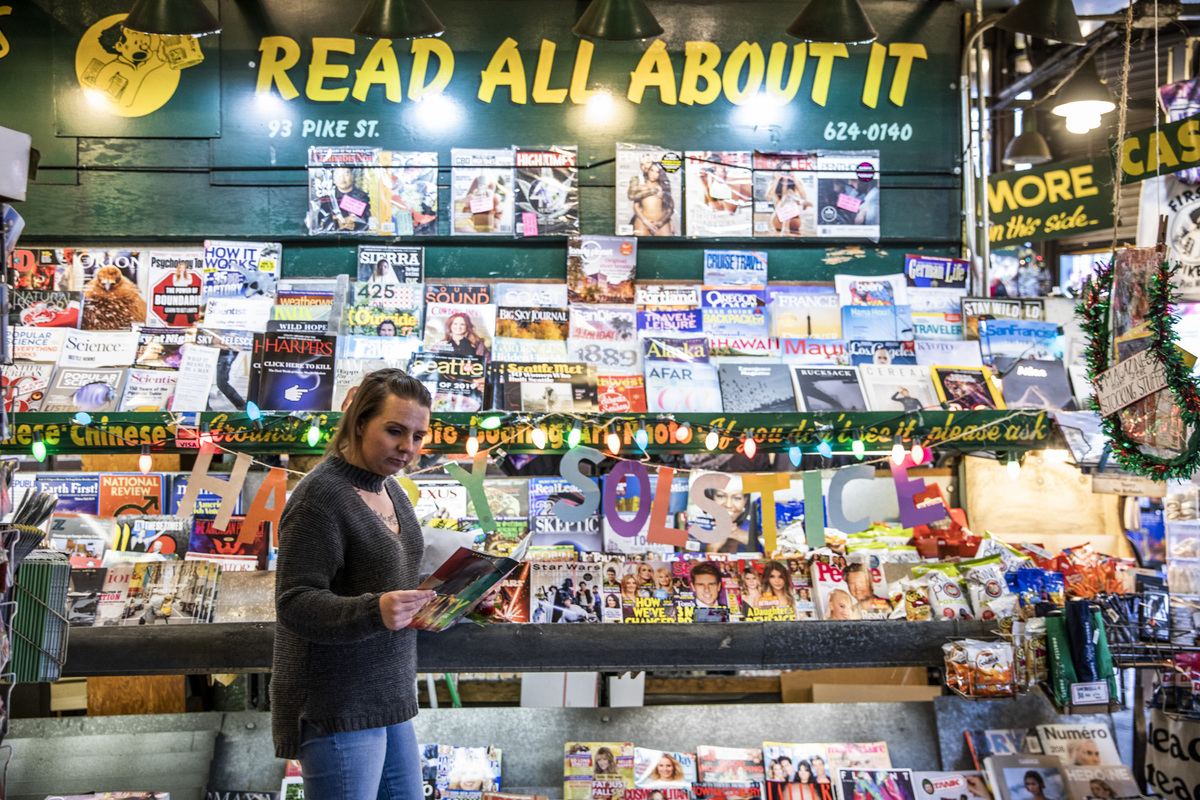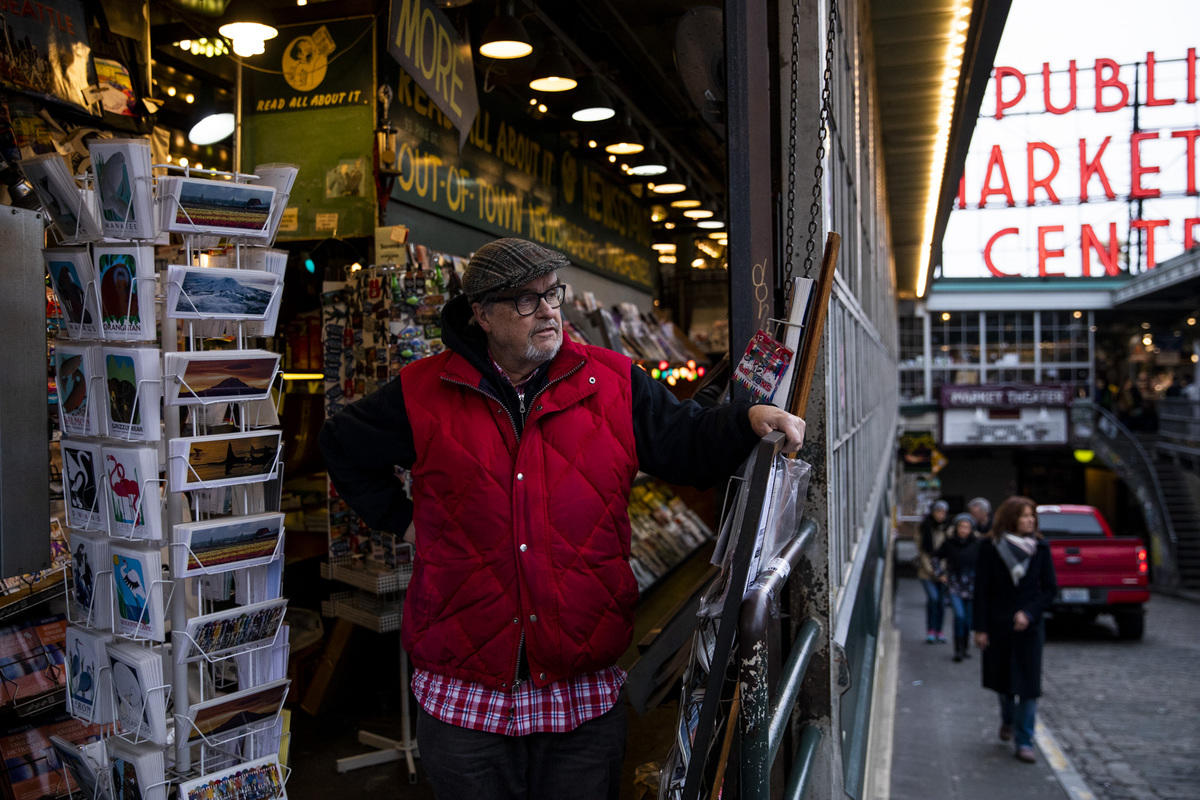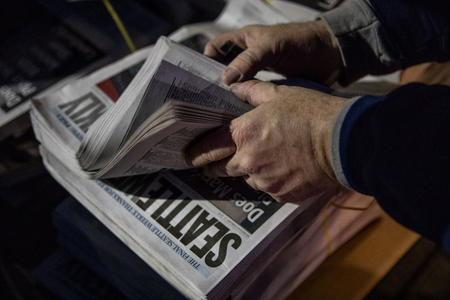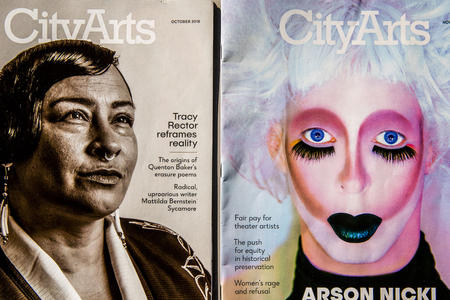Stuck to the bottom of the paper, a sticker declared: “I Love the Free Press.”
Lauckhart, 78, rested his hand on a red Seattle Post-Intelligencer windbreaker he had stretched over a hand truck.
“My dearly departed friend,” he noted wistfully, mourning the daily publication that stopped printing a decade back — a reminder of when Seattle was a two-newspaper town.
Two months later, his beloved First & Pike News faces its own demise after struggling for years. Lauckhart announced on Friday, Dec. 13, that he is permanently closing the iconic stand at the southeast entrance to Pike Place Market, as of Dec. 31.
A sort of unofficial town square, the newsstand has been the site of countless impromptu chats over the decades, a place where regulars and tourists would strike up conversations based on a magazine someone was holding or the headline on a newspaper.
Browsing at First & Pike News always proved a treasure hunt. Besides the five newspapers sold at the counter, you never knew what you were going to discover among the eclectic array of magazines — nearly 2,000 on the shelves, from the sacred to the profane. Religious publications, such as Lion’s Roar: Buddhist Wisdom to Awaken Your Heart and Mind, sat alongside a comic book drawn by a local artist featuring Jesus, on the cross, admiring the view of his house from up there.
You could practice Français by reading French GQ, take an imaginary trip down the Nile with one of the many travel magazines. Or pick up a copy of Doug Bright’s Heritage Music Review, a monthly guide to early rock, blues, country folk and traditional jazz in the Seattle area.
The shelves also held two dozen publications devoted to autos, a dozen motorcycle magazines, several train magazines, a few wood-carving periodicals and publications on beekeeping and organic farming. Many of them for less than $10.
On a recent afternoon, most of his customers had gray threaded into their hair — with the exception of a 10-year-old looking for skateboarding magazines. He found one.
Another important aspect of the stand was Lauckhart himself, who served as kind of a father figure for downtown denizens — some as old or older than he — who lived in subsidized housing at the Market and elsewhere. Whether it was helping a local drunk dry out by dropping him off at various campsites in the region, or calming a nervous horseracing fan who fretted about getting his lottery ticket cashed, Lauckhart proved a steadying force.
“Lee helped people through their difficult times as a hobby,” said one of his friends at the anniversary celebration. As the rising costs of living in Seattle welcomed affluent tech workers but priced out others, Lauckhart acted as kind of a protector for those on the margins.
Lauckhart’s employees embraced this community, too. Newsstand manager Rebecca Eider would walk retired news carrier Pat Hickey back to his assisted living center down the street each morning after he bought his Seattle Times. One recent Sunday, she greeted an older gent named Walter, who had a bushy grey beard. Sporting a Greek fishing cap, Walter regularly haunts the sidewalk in front of the stand, hoisting a sign that reads, “Old Hippies Need Love Too.”
“Do people hug him?” I asked.
“They give him money,” Eider responded. “He’s living on a very fixed income.” Eider added, “He brings me coffee every morning. I wouldn’t lie about that. Caffeination is very important.”
On Dec. 15, the Sunday after Lauckhart announced he would close, some of the stand’s more affluent regulars mourned the impending absence. “I’m so sorry about this place. What am I going to do?” said Virginia Washburn, buying a New York Times. “It’s such a loss.”
“It’s tragic,” said Alec Brindle, a tweed-jacketed Magnolia resident who picked up a New York Times and Financial Times. He has been a customer for two decades.
Eider watched a man in a brown blazer stride away after a purchase. “That’s the librarian,” she whispered in hushed tones reserved for houses of worship. “The library is the only repository of written word in the city.”
It’s ironic that a town with so many voracious readers cannot keep a newsstand afloat. Seattle was named a City of Literature in 2017 and dubbed the second most literate city in the nation that year. The closure feels like one more nail in the coffin of print journalism.

Since the news of its closing, First & Pike News has tallied record-high sales. And the impeachment of President Donald Trump brought a surge of newspaper sales the following day — the New York Times sent 30 copies, twice the usual amount. They were sold out before noon. But the recent burst of purchases can’t make up for decades of low digits.
A few years back Lauckhart received permission from Market authorities to sell sundries. Water and gum, sold at healthy markups, proved more lucrative than print journalism. He refused to sell cigarettes, but did offer Zig-Zag rolling papers. He had to fight some of his fellow Market merchants to sell Space Needle keychains and Bigfoot magnets — they feared the competition.
“We would have been gone 10 years ago at any other location,” Lauckhart told me, explaining that his spot at tourist central helped keep him afloat.
A couple of years passed and finally black ink returned. Lauckhart was relieved, but it was a bitter Chiclet to chew. “We used to have people come in and they actually read,” his friend Arthur Pritchard recalled him saying. He remembered Lauckhart’s lamentation: “People actually bought magazines. Now they just want gum.”
But the news dealer swallowed his pride, even when clerk George Cottrell took it upon himself to create a large sign with directions to the Market’s gum wall (which Lauckhart loathed) to boost sales of Hubba Bubba and cut down on pesky questions.
Then in mid-2019, Lauckhart’s luck began to dry up.
“Expenses outran the revenues,” Lauckhart told me at the stand two weekends ago, extending his arms as if they were balancing scales. “I was going deeper into debt. I believe in paying as you go. If I’m not able to do that, I’ll pull the curtains and go home.”
Packets of junk food shoved onto a shelf in front of the yearly almanac hinted at his despair. Lauckhart picked up a bag of Cracker Jack wedged alongside Slim Jims and Skinny Pop popcorn. “Look at this, I hate crap,” he said, dispirited by what was apparently a last-ditch effort at survival.
Lauckhart opened the newsstand in October 1979, with Seby Nahmias, who had been hawking newspapers alongside the Market for nearly 40 years. On the cusp of middle age at 39, Lauckhart was determined to make this project an adventure.
As a boy, he was impressed by the beams of light that sometimes sliced through Seattle’s foggy darkness, beckoning residents to test-drive midcentury model cars that had just arrived at dealerships lining Aurora Avenue. So when it came time to announce his and Nahmias’ new venture at the corner of First Avenue and Pike Street, he wanted to replicate that childlike sense of wonder and draw Seattleites’ eyes to the Market’s southeast portal.
The first check Lauckhart wrote on the newsstand’s account was $100, to rent a searchlight, which blazed a path across the sky to announce the Oct. 25, 1979, grand opening of Read All About It (the stand’s original name, still emblazoned behind the magazine rack).
“Seby thought I was nuts,” Lauckhart recalled. But the two donned tuxedos for the event and served cake and champagne to dozens of revelers.
Unfortunately, there wasn’t much merchandise suitable for a general audience on that grand opening evening. Blame that on the stand’s location on First Avenue, where adult businesses and girly shows blossomed. “A major magazine distributor, Adams News, rolled in a hand truck with $500 worth of magazines but half of it was pornography,” Lauckhart recalled. “It was mostly Penthouses and Playboy and only one copy of Time magazine.”
Luckily, a mailman had delivered a battered cardboard box filled with treasure — 40 copies of the Nome Nugget, the Alaska paper Lauckhart’s uncle Albro Gregory had edited and published. Nahmias and Lauckhart managed to sell a few of them opening night. The newsstand carries the Nugget to this day.
Steve Dunnington joined the partnership in 1980, after working in the apple orchards of Eastern Washington. A gifted writer, he was taking journalism classes at night and writing columns for the Market News and the Seattle Times, in addition to keeping the stand’s books.
Business boomed in the ’80s, but as the internet grew in popularity, the stand’s fortunes began to falter. By 1997, Dunnington said, it was clear that magazines and newspapers were selling less and less.
Although they tried to paste a happy face over declining revenues (Dunnington had once insisted sales of magazines that explained how to use the internet were making up for the loss), they could see the writing on the wall — and on the electronic devices.

Dunnington — who previously had opened two newsstands, Steve’s Fremont News and Broadway News — sold his partnership to Lauckhart in 2000, partly because of declining sales but also because they had different philosophies. (Nahmias had died in 1987.) Lauckhart liked to run the business by the seat of his pants, while Dunnington wanted to keep precise track of inventory, using a cash register, Dunnington told me a few weeks ago.
“That’s where the money is,” Lauckhart declared, pointing out that a cash register is an easy target for thieves. “Why would we want people to know?” He believed his clerks should to be free to roam around the stand, away from the counter.
He offered his employees leeway in many respects. Neil Giardino, a First & Pike newsstand veteran and current associate producer at ABC News, explained it this way: “I could say to someone, ‘Fuck off.’ Other jobs — that would be grounds for termination.”
Lauckhart paid clerks above minimum wage, offered health insurance and gifted each hundreds of dollars in bonuses at the holidays, although the total staff has dwindled since 2011 from six to half that.
Bill Lundgren, the newsstand’s most senior clerk, worked there on and off for more than 20 years. When someone handed him a magazine they were buying, he would study the cover for a few seconds and nod approvingly — especially if it had anything to do with his favorite film director, Bernardo Bertolucci — as if it was the most brilliant purchase in the world.
But Lundgren, also a talented ceramicist, was kind of a “crazy hothead” in the old days, according to Lauckhart.
“If Lee wasn’t such a good-hearted person, I would have been fired,” Lundgren admitted, when I spoke with him in 2013. After suffering a stroke in his 70s, he continued working at the stand until he retired in 2016. Lundgren died in September, just before the 40th anniversary. A memorial board at the celebration featured photos of Lundgren throughout the years, alongside some of his poetry.
“No hugs, no speeches,” Lauckhart had warned me before that party, where champagne and cake were served, just as at the opening. I asked Aana, his daughter, “Isn’t he sentimental?”
“Too sentimental,” she confided. At the event, Lauckhart mostly kept himself behind the counter, where he could get as few hugs as possible, although he did make an exception for his former partner, Dunnington.
“I certainly wouldn’t be here without you,” Lauckhart told him.
“You’re the one. You’re the rock,” Dunnington insisted.
Later, Lauckhart ventured out from behind the counter for the champagne toast and group photo.
Dunnington reflected on the warm friendships Lauckhart nurtured at the newsstand — more important than riches, he said. “Lee’s not changed the world, but it’s a world he’s made and it’s wonderful.”






